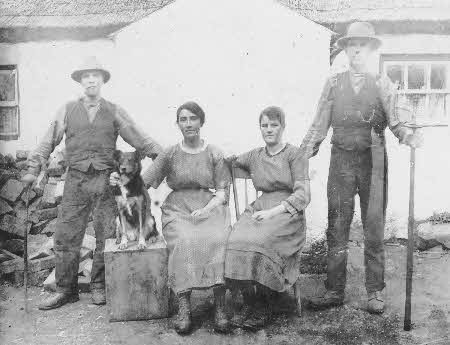
May Eve
THE DIGGER

A family photographed in the Rushyhill area in the early 20th century. One of the females in this family was responsible for adorning the doors and windows of the homestead on May eve with Mayflowers to ward off the witches.
May Eve was once an important and significant time of the year amongst past generations. I have heard several local stories combining ritual and superstition.
In one particular farmstead, situated in a rural part of the district, it was traditional to place a fork or grape in front of an air hole to a byre. It was believed that this would catch the witches, prevent them from venturing inside the byre and “bewitching” the beasts therein.
In an adjacent townland another ritual was practised with the intention of warding off the supernatural. One of the ladies residing there religiously gathered Mayflowers and placed them at doors and windows of the farmstead every May eve.
Locally, I was shown an old scrapbook containing cuttings dating back to Victorian times. One of the cuttings contained a stern warning to readers against removing coal from the house when anyone was sick. It was further stated that you should “not under any circumstance allow a coal out on a Monday Morning, nor on a May morning, or while there is an unbaptised baby in the house.”
May eve traditions are recorded also in the Ordnance Survey memoirs for the parishes of Lambeg and Blaris in the 1830’s. In Lambeg it was a custom to have a May bush which consisted of a thorn or branch of a tree. It was adorned with flowers and ribbons and carried about by a large number of people who had gathered to celebrate the occasion. The writer of the memoirs informs us that the procession ended in merriment that included dancing, singing and drinking.
In Lisburn, the writer was a witness to the local May eve celebrations that were said to have attracted approximately four hundred men and boys. They assembled at the Market House at 7pm. A large decayed tree estimated to be about thirty feet in height was placed in the “broad part of the street” and a bonfire consisting of fir, turf and sticks was lit at the base. A lighted torch was secured at the top of the tree. The writer witnessed a boy with a lantern in his hand scaling the tree where he remained for two hours. A Scotch piper, wearing highland dress played several tunes. The piper and onlookers then formed a circle round the fire holding hands. It was claimed that when extended, the chain of people would have reached half a mile in length. The celebrations came to an end when the town’s night watchman came on duty at 10pm.
An article printed in the Lisburn Standard in 1891 there is a reference to “various freets” at May eve in some parts of Ireland. There was a reference to the pulling of Mayflowers, placing them over the door, well and byre door to keep out the witches, as it was believed that they had more power at this time of year.
In the mid 1860’s it was customary for people from all social classes and denominations to gather yarrow in the area of the Bog Meadows in Belfast on May eve. On May 1st 1865 the Belfast Newsletter reported that during such an event the previous evening, sectarian remarks and party expressions had been exchanged amongst some of those present which led to violent confrontations. “Those who were peaceably and pleasantly engaged in gathering flowers were found collecting stones and every available missile, which they hurled at one another in a spirit of bitter animosity.” It was reported that not more than one hundred persons were engaged in this activity. The following year, as a precaution, the constabulary were present in force, preventing a repeat of past events.
Over a decade later, further disturbances were
being reported in Belfast at this time of the year.
Some writers of that period informed their readers that although locals
no longer participate in the usual mirth making around the well known
pole in May, the gathering of yarrow continued on May eve. It was
another popular plant at this time of the year and crowds of people were
“resorting to the dykes and hedgerows in pursuit of the prophetic
treasure.” In 1891 the Lisburn Standard made mention of the tradition of
pulling a piece of yarrow and saying to yourself “Sweet yarrow, show me
my love.” You were then instructed to go in and speak to no one that
night, otherwise the charm would be broken. It was believed that you
would dream of your future husband or wife on that evening.
“The gathering of yarrow and the subsequent dreaming and the amusing recitals of imaginary circumstances are matters that are familiar to all.”
Many of the traditions once associated with May eve, also referred to as Beltaine, have passed in to the annals of our history books. It was on May eve that sacrifices and offerings were made to Beal or Belus in pagan times. Even in 1826 the press reported that the traditional “ceremony of making cows leap over a lighted straw or faggots on May eve is not yet entirely obsolete in Ireland.”
The Digger can be contacted via The Ulster Star office, or by emailing diggerarticle@hotmail.com
14/03/2012
